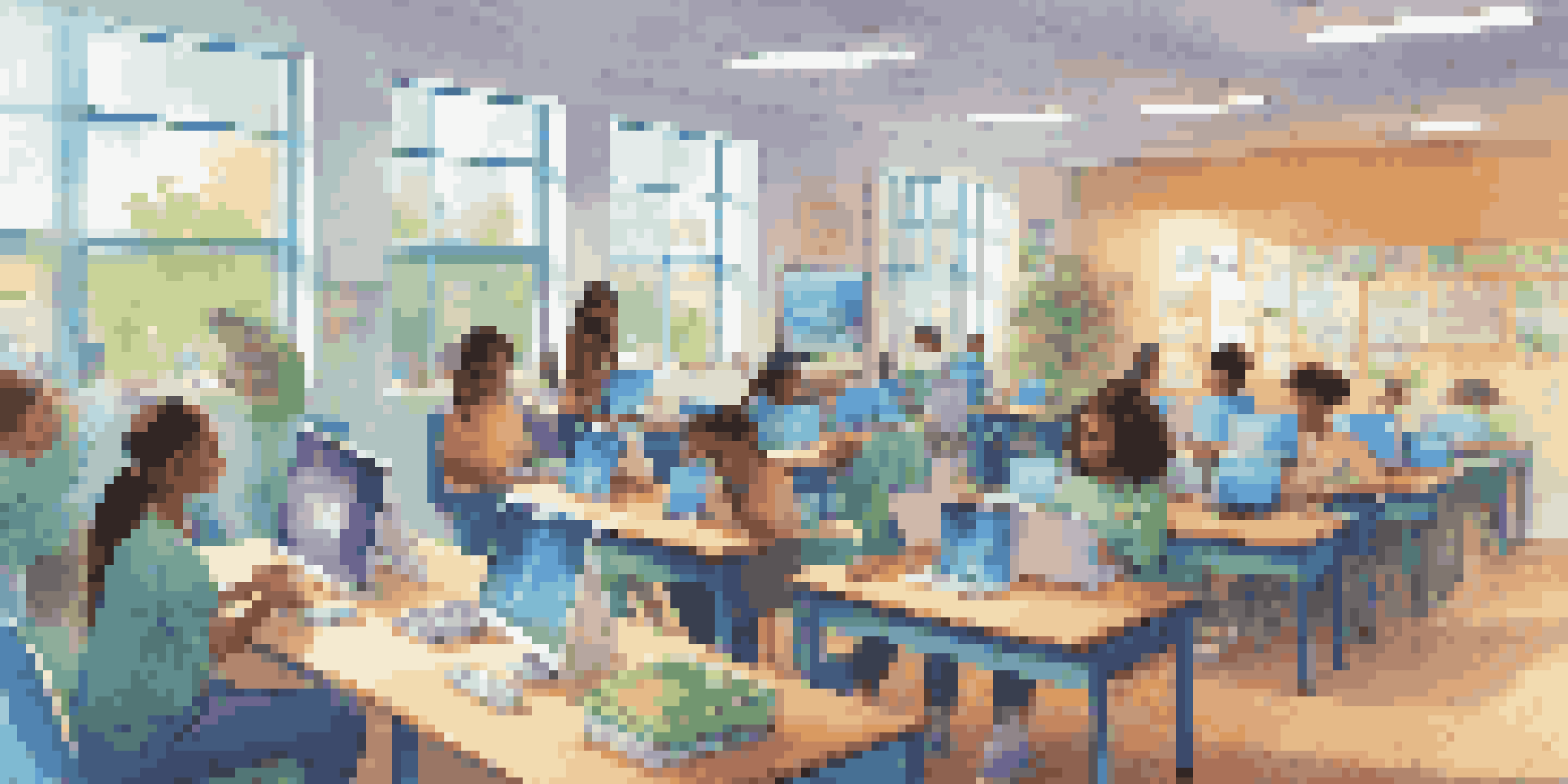The Evolution of Continuing Education in the Digital Age

Understanding Continuing Education: A Brief Overview
Continuing education refers to the process of learning new skills or knowledge after formal schooling. It has long been a crucial aspect of professional development, allowing individuals to stay competitive in their fields. Traditionally, it involved classroom settings and in-person workshops, which were often limited by geography and resources.
Education is the most powerful weapon which you can use to change the world.
As industries evolved and technology advanced, the need for flexible learning options became apparent. This shift paved the way for various formats that cater to different learning styles and schedules. The goal has always been to empower individuals to grow and adapt, especially in rapidly changing job markets.
Today, continuing education encompasses a wide range of options, from online courses to webinars and self-paced programs. This flexibility enables learners to pursue their educational goals while balancing work, family, and other commitments. It sets the stage for a more inclusive and diverse learning environment.
The Rise of Online Learning Platforms
The advent of the internet has dramatically reshaped the landscape of continuing education. Online learning platforms like Coursera, Udemy, and LinkedIn Learning have made it easier for anyone to access high-quality educational resources. This democratization of learning allows individuals from various backgrounds to enhance their skills at their own pace.

These platforms offer a plethora of courses covering numerous subjects, ranging from coding to creative writing. With just a few clicks, learners can find courses that fit their interests and career goals. Additionally, many of these platforms provide certificates that can boost resumes and professional profiles.
Flexible Learning Options Emerge
Continuing education has evolved to include diverse formats like online courses and mobile learning, providing flexibility for busy individuals.
The convenience of online learning has made it a popular choice for busy professionals. As people seek to balance multiple responsibilities, the flexibility to learn anytime and anywhere has become increasingly appealing. This shift has not only expanded access but also transformed how we view education.
The Role of Social Media in Learning Communities
Social media has emerged as a powerful tool for fostering learning communities in the digital age. Platforms like Facebook, LinkedIn, and Twitter allow individuals to connect, share resources, and engage in discussions related to their fields of interest. This sense of community can enhance motivation and accountability among learners.
The beautiful thing about learning is that no one can take it away from you.
Online forums and groups provide a space for individuals to ask questions, share experiences, and collaborate on projects. This peer-to-peer interaction can be invaluable, as it often leads to insights and perspectives that might not be found in traditional educational settings. This collaborative learning experience can deepen understanding and retention of new information.
Moreover, social media enables educators to reach wider audiences, offering webinars and live Q&A sessions that benefit many. This integration of social media into continuing education creates a dynamic and interactive environment, making learning more engaging and relevant to today’s learners.
The Impact of Mobile Learning on Accessibility
Mobile learning, or m-learning, has further increased accessibility in continuing education. With smartphones and tablets, learners can access courses and materials on-the-go, breaking down the barriers of time and location. This convenience aligns perfectly with the fast-paced lives many lead today.
M-learning is particularly beneficial for those who may not have the opportunity to attend traditional classes. Whether commuting to work or waiting in line, learners can take advantage of every spare moment. This flexibility promotes continuous learning and helps individuals stay current in their fields.
Social Media Boosts Learning Communities
Social media platforms facilitate collaboration and motivation among learners, enhancing the overall educational experience.
Additionally, many educational apps come with interactive features such as quizzes, videos, and forums. These tools enhance the learning experience, making it more engaging and interactive. As a result, mobile learning continues to gain popularity and reshape how we approach education.
Gamification: Making Learning Fun and Engaging
Gamification is the process of incorporating game-like elements into educational experiences. This approach has gained traction in recent years as educators seek innovative ways to engage learners. By adding elements such as points, badges, and leaderboards, continuing education becomes more enjoyable and motivating.
This strategy taps into the natural human desire for competition and achievement. For instance, many online platforms use gamification to encourage learners to complete courses and gain certifications. As learners progress, they receive rewards that recognize their efforts and milestones, making the learning journey feel more rewarding.
Moreover, gamification can enhance retention and understanding of complex concepts. By turning learning into a game, individuals are more likely to stay focused and retain information. As this trend continues to grow, it promises to make continuing education not only effective but also fun.
The Importance of Microlearning in Busy Lifestyles
Microlearning is a trend that focuses on delivering content in bite-sized formats, making it an ideal solution for today’s busy learners. This approach allows individuals to consume information quickly, often in just a few minutes. It caters to short attention spans and the need for quick, digestible learning experiences.
Microlearning can take many forms, such as short videos, infographics, or interactive quizzes. This flexibility allows learners to choose how they engage with the material. As a result, it fits seamlessly into their daily routines, enabling them to learn without feeling overwhelmed.
Future Trends Shape Lifelong Learning
Emerging technologies like AI and virtual reality are set to personalize and enhance continuing education, promoting a culture of continuous development.
Furthermore, microlearning can be highly effective for reinforcing knowledge. By revisiting concepts in small doses, learners can solidify their understanding and apply it in real-world scenarios. This approach is particularly beneficial in fast-paced industries where staying up-to-date is crucial.
Future Trends in Continuing Education
As technology continues to evolve, so too will the landscape of continuing education. Emerging technologies like artificial intelligence and virtual reality are set to revolutionize how we learn. These advancements promise to create more personalized and immersive experiences that cater to individual learning styles.
For instance, AI can analyze learners' progress and tailor educational content to meet their specific needs. Virtual reality can simulate real-world scenarios, providing hands-on experience in a controlled environment. These innovations have the potential to enhance engagement and retention significantly.

Moreover, as the importance of lifelong learning becomes increasingly recognized, we can expect to see more organizations investing in employee development. This trend will encourage a culture of continuous growth and adaptability, essential for navigating the complexities of the modern workforce.